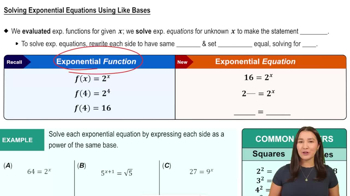Table of contents
- 0. Review of Algebra4h 16m
- 1. Equations & Inequalities3h 18m
- 2. Graphs of Equations43m
- 3. Functions2h 17m
- 4. Polynomial Functions1h 44m
- 5. Rational Functions1h 23m
- 6. Exponential & Logarithmic Functions2h 28m
- 7. Systems of Equations & Matrices4h 6m
- 8. Conic Sections2h 23m
- 9. Sequences, Series, & Induction1h 19m
- 10. Combinatorics & Probability1h 45m
6. Exponential & Logarithmic Functions
Solving Exponential and Logarithmic Equations
Problem 33b
Textbook Question
Solve each exponential equation in Exercises 23–48. Express the solution set in terms of natural logarithms or common logarithms. Then use a calculator to obtain a decimal approximation, correct to two decimal places, for the solution. e^(1−5x)=793
 Verified step by step guidance
Verified step by step guidance1
Start by taking the natural logarithm of both sides of the equation: \( \ln(e^{1-5x}) = \ln(793) \).
Use the property of logarithms that \( \ln(e^a) = a \) to simplify the left side: \( 1 - 5x = \ln(793) \).
Isolate the term with \( x \) by subtracting 1 from both sides: \( -5x = \ln(793) - 1 \).
Divide both sides by -5 to solve for \( x \): \( x = \frac{\ln(793) - 1}{-5} \).
Use a calculator to find the decimal approximation of \( x \) by evaluating the expression \( \frac{\ln(793) - 1}{-5} \) to two decimal places.
Recommended similar problem, with video answer:
 Verified Solution
Verified SolutionThis video solution was recommended by our tutors as helpful for the problem above
Video duration:
3mPlay a video:
Was this helpful?
Key Concepts
Here are the essential concepts you must grasp in order to answer the question correctly.
Exponential Equations
Exponential equations are mathematical expressions in which variables appear as exponents. To solve these equations, one typically isolates the exponential term and applies logarithmic functions to both sides. This allows for the conversion of the exponential form into a linear form, making it easier to solve for the variable.
Recommended video:

Solving Exponential Equations Using Logs
Natural and Common Logarithms
Natural logarithms (ln) and common logarithms (log) are two types of logarithmic functions. The natural logarithm is based on the constant e (approximately 2.718), while the common logarithm is based on 10. Understanding how to use these logarithms is crucial for solving exponential equations, as they help to simplify the equation and isolate the variable.
Recommended video:

Graphs of Common Functions
Calculator Usage for Approximations
Using a calculator to obtain decimal approximations is an essential skill in solving exponential equations. After isolating the variable and applying logarithms, the resulting expression often requires numerical evaluation. Calculators can provide quick and accurate decimal approximations, which are particularly useful for presenting solutions in a clear and concise manner.
Recommended video:

Foci and Vertices of Hyperbolas

 4:46m
4:46mWatch next
Master Solving Exponential Equations Using Like Bases with a bite sized video explanation from Callie
Start learningRelated Videos
Related Practice












